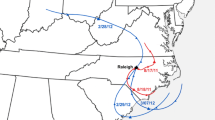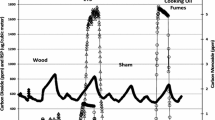Abstract
Time-series studies have shown that the lag time between elevated particulate air pollution (PM) and increases in cardiovascular-related hospital admissions and death is very short-1 d or less. If PM does cause serious cardiovascular effects shortly after exposure, one would expect to see some physiological change during exposure. In this study, spontaneously hypertensive rats (SHRs) with surgically implanted blood pressure transmitters were exposed to concentrated ambient PM (CAPS) for 4 h to determine whether CAPS inhalation causes immediate effects. The rats were also exposed to sulfuric acid aerosols because acid is one of the components of PM that could potentially activate irritant receptors and cause effects during exposure. Exposure to CAPS caused a striking decrease in respiratory rate that was apparent soon after the start of exposure and stopped when exposure to CAPS ceased. The decrease in respiratory rate was accompanied by a decrease in heart rate. Exposure of the same rats to fine-particle-size sulfuric acid aerosol also caused a significant decrease in respiratory rate similar to the effects of CAPS. Ultrafine acid had the opposite effect on respiratory rate compared to CAPS. Because acids have been shown to evoke sensory irritant responses in rodents, the similarity between the effects of fine acid aerosol and CAPS suggests that CAPS activates airway-irritant receptors during exposure.
Similar content being viewed by others
References
Dockery, D.W., Schwartz, J., and Spengler, J.D. (1992). Air pollution and daily mortality: associations with particulates and acid aerosols. Environ. Res. 59:362–373.
Moolgavkar, S.H. (2000). Air pollution and daily mortality in three U.S. counties. Environ. Health Perspect. 108:777–784.
Pope, C.A. (2000). Epidemiology of fine particulate air pollution and human health: biological mechanisms and who's at risk? Environ. Health Perspect. 108(S4):713–723.
Samet, J.M., Dominici, F., Curriero, F.C., Coursac, I., and Zeger, S.L. (2000). Fine particulate air pollution and mortality in 20 U.S. cities, 1987–1994. N. Engl. J. Med. 343:1742–1749.
Peters, A., Dockery, D.W., Muller, J.E., and Mittleman, M.A. (2001). Increased particulate air pollution and the triggering of myocardial infarction. Circulation 103:2810–2815.
Gamble J.F. and Lewis R.J. (1996). Health and respirable particulate (PM10) air pollution: A causal or statistical association? Environ. Health Perspect. 104:838–850.
Ghio, A.J., Kim, C., and Devlin, R.B. (2000). Concentrated ambient air particles induce mild pulmonary inflammation in healthy human volunteers. Am. J. Crit. Care Med. 162:981–988.
Godleski, J.J., Verrier, R.L., Koutrakin, P., and Catalano, P. (2000). Mechanisms of morbidity and morality from exposure to ambient air particles. Health Effects Institute Research Report 91.
Nielsen, G.D. (1991). Mechanisms of activation of the sensory irritant receptor by airborne chemicals. Crit. Rev. Toxicol. 21:183–208.
Coleridge, H.M. and Coleridge, J.C.G. (1986). Reflexes evoked from tracheobronchial tree and lungs, in Handbook of Physiology. The Respiratory System. Control of Breathing, Sect. 3, Vol. II, Part 1 (Cherniack, N.S. and Widdicombe, J.G., eds.), pp. 395–429, American Physiology Society, Bethesda, MD.
Alarie, Y. and Keller, L.W. (1973). Sensory irritation by capsaicin. Environ. Physiol. Biochem. 3:169–181.
Lundblad, L. (1984). Protective reflexes and vascular effects in the nasal mucosa elicited by activation of capsaicinsensitive substance P-immunoreactive trigeminal neurons. Acta Physiol. Scand. 529:1–42.
Pinto, Y.M., Paul, M., and Genten, D. (1998). Lessons from rat models of hypertension: from Goldblatt to genetic engineering. Cardiovasc. Res. 39:77–88.
Schaper, M. (1993). Development of a database for sensory irritants and its use in establishing occupational exposure limits. Am. Ind. Hyg. Assoc. J. 54:488–544.
Gordon, T., Nadziejko, C., Chen, L.C., and Schlesinger R. (2000). Effects of concentrated ambient particles in rats and hamsters: An exploratory study. Health Effects Institute Research Report 93.
Kimmel, T.A., Chen, L.C., Bosland, M.C., and Nadziejko, C. (1997). Influence of acid aerosol droplet size on structural changes in the rat lung caused by acute exposure to sulfuric acid and ozone. Toxicol. Appl. Pharmacol. 144: 348–355.
Chen, L.C., Fine J.M., Qu, Q.-S., Amdur, M.O., and Gordon, T.G. (1992). Effects of fine and ultrafine sulfuric acid aerosols in guinea pigs: alterations in alveolar macrophage function and intracellular pH. Toxicol. Appl. Pharmacol. 113:109–117.
Schauer, J.J. and Cass, G. R. (2000). Source apportionment of wintertime gas-phase and particle phase air pollutants using organic compounds as tracers. Environ. Sci. Technol. 34:1821–1832.
Tominaga, M., Caterina, J., Malmberg, A.B., et al. (1998). The cloned capsaicin receptor integrates multiple pain-producing stimuli. Neuron 21:531–543.
Author information
Authors and Affiliations
Corresponding author
Rights and permissions
About this article
Cite this article
Nadziejko, C., Fang, K., Nadziejko, E. et al. Immediate effects of particulate air pollutants on heart rate and respiratory rate in hypertensive rats. Cardiovasc Toxicol 2, 245–252 (2002). https://doi.org/10.1385/CT:2:4:245
Received:
Revised:
Accepted:
Issue Date:
DOI: https://doi.org/10.1385/CT:2:4:245




